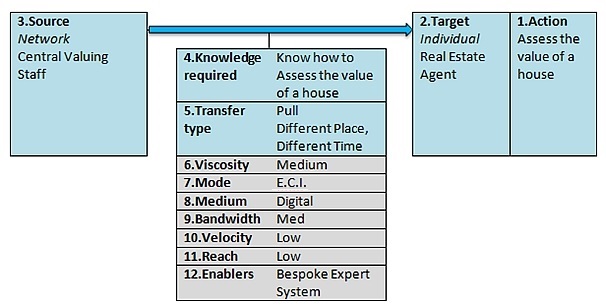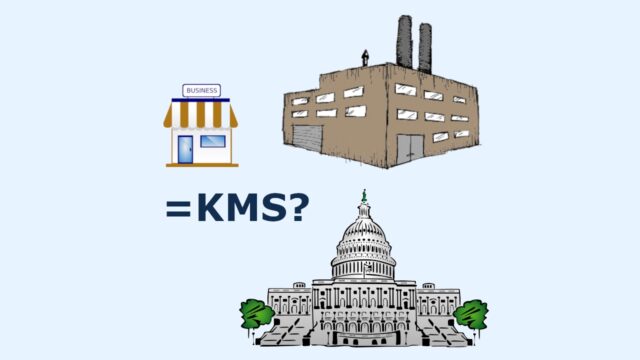
A knowledge flow notation for designing knowledge management systems
Introduction
There is a need for a logical and practical model for mapping the flow of knowledge in an organisational function to support the design or adaption of supporting technology and systems. There are a number models, research, tools and practices on mapping knowledge in an organisation. Some of these include the Perez-Soltero knowledge audit methodology1, the knowledge audit process by the Asian Development Bank2, the knowledge mapping process described in the Knowledge Bucket wiki 3, Laurer’s KM audit model 4, Dave Snowden’s ASHEN model 5, Patrick Lambe’s Knowledge Wheel 6, and the taxonomic model by Alavi & Leidner 7. All of these frameworks are valid, but some are more useful than others for mapping knowledge sources and gaps.
Discussion
An example of knowledge flow mapping is Zhuge8 who proposed a knowledge flow model for peer-to-peer team knowledge sharing and management in cooperative teams. Similarly, Rodríguez-Elias et al.9 identify that there is a need for a Process Modelling Language to analyse knowledge flows by providing explicit representations of issues such as the knowledge consumed or generated in activities. Their model is in a Unified Modelling Language (UML) format that could have greater detail. The APQC’s Knowledge Flow Process Framework10 (APQC, 2014), as with many of their articles on KM, confuses knowledge with information and does not provide a mapping protocol.
Davenport & Prusak11 discuss the viscosity and velocity of knowledge flows, which provides an effective perspective on some of the attributes of a knowledge flow notation. Not only do we need to map the person or teams who require the knowledge (target) and the person who has the knowledge (source), but there is a need to describe the channel through which the knowledge should flow. This breakdown is critical to the analysis and development of an effective knowledge management system (KMS). Velocity is a useful term to describe how fast the knowledge needs to flow through a system. Is it required immediately for tactical and real-time mission-critical issues, or can it be refined and pulled/pushed in slack time? Davenport & Prusak also refer to viscosity as the richness or thickness of the knowledge that gets absorbed. I consider that this should include an element of ‘stickiness’ or knowledge retention as well.
While the SECI Model12 is often seen as dated and simplistic, the notion of socialisation and internalisation as the two fundamental processes of knowledge sharing is still an effective perspective as it highlights the human element in the knowledge transfer. SECI is also one of the few models that considers the shared environmental context for knowledge creation and transfer – Ba.
Proposal
A practical knowledge flow notation (KFN) will allow us to map the flow of knowledge and assist in designing, developing and implementing knowledge management systems (KMS) as distinct from information management systems (IMS).
There are lessons to be learned from the models, methodologies and presentation of information and business flow notations. The two most popular are Unified Modelling Language (UML) and Business Process Model and Notation (BPMN). The Object Management Group13 is responsible for both models. BPMN is a notation that is readily understandable by business users as it shows the flow of a business process in logical terms. It is less effective in mapping relationships although swim-lane diagrams do go some way. BPMN scores well against Kano’s model of customer satisfaction14 in that it is functional, logical and attractive.
A similar set of attributes need to be achieved for a knowledge flow notation (KFN). I propose that there are 12 attributes that can describe the way in which knowledge is transferred. Only attributes 1-5 are intended to be mandatory. The other attributes enrich the picture and provide additional information that will improve the design of a KMS.
Attributes of a knowledge flow notation (KFN)
Mandatory attributes
- What is the action or business process to be undertaken or the service provided that requires additional knowledge
An unstructured statement that describes the task(s), business process, activity or role that requires the acquisition and use of knowledge.
- Who is the target
The knowledge recipient who can be an individual, a group, a network or a specific demographic.
- Who or what is the source of the knowledge
Sources of knowledge can include: individual, group, network, aggregation index (AI), or machine generated structural capital (information).
- What is the knowledge that is being transferred
This can be categorised as: know why, know how, know who, know what, know where, or know when.
- The transfer type of knowledge
The knowledge transfer type indicates whether the knowledge is pulled or pushed. This should also be indicated by the direction of the arrow in the model. The flow can also be 2-way (interactive) and occurring at the same place, same time, different place, different time, or a combination.
Optional attributes
- Viscosity of the knowledge to be transferred
The extent to which the knowledge needs to be clearly understood, retained and acted on. Is also influenced by the extent of trust and authenticity.
- The mode of knowledge transfer is critical to selection of the appropriate medium
The SECI modes of knowledge transfer are: socialisation, externalisation, internalisation, with the potential for combination occurring in some instances.
- What is the medium to be used for the knowledge transfer
The medium for the knowledge transfer could be: face to face (F2F), hard-copy, digital (passive), messaging (active), audio, image/diagram, video, data, or a combination of these.
- Bandwidth
The volume of the knowledge being transferred. Trust and the quality of social connections are an enabler of this element.
- Velocity
The speed at which knowledge needs to move in an organisation.
- Reach
The extent to which the knowledge needs to penetrate an organisation. Is it knowledge that everyone needs to know, or just a few people to meet a specific knowledge task.
- The enablers provide a shared context for knowledge creation and transfer (Ba)
Enablers of a KMS include physical spaces, as well as information and communication technology ranging from video-conferencing, email, learning management system (LMS), expert systems, knowledge mapping, expertise locators, blogs, wikis, to physical enablers such as co-design spaces, training rooms, cafes, or water coolers.
An example of the application of knowledge flow notation (KFN)
Such a modelling notation may look like the figure below. This is for a scenario where a real estate agent needs to know how to value a house for sale on the open market. The process requires an understanding of the history of the market in specific areas, trends, economic conditions, and projections. The action requires an understanding of the positive and negative attributes of a property and how to asses, aggregate and analyse all of the elements in order to establish an accurate valuation.

Application of knowledge flow notation to a scenario where a real estate agent needs to know how to value a house for sale on the open market
Conclusion
The objective of this modelling notation is to develop something that is of value to industry. Mapping the flow of knowledge to support a business process in a consistent format allows us to better understand and analyse the knowledge needs of an organisation and design superior systems. The attributes listed in the above model are a ‘first cut’ and are open for discussion. The plan is to road-test this model with the 2016 cohort for Knowledge Management Systems at the University of Canberra during the winter semester. This will be supplemented with a webinar hosted by AuSKM with the results to be aggregated into an academic paper for future publication. Constructive and critical comments are most welcome.
References:
- Perez-Soltero, A., Barcelo-Valenzuela, M., Sanchez-Schmitz, G., Martin-Rubio, F., & Palma-Mendez, J. T. (2006). Knowledge audit methodology with emphasis on core processes. In European and Mediterranean Conference on Information Systems (pp. 1-10). ↩
- Asian Development Bank (2008), Auditing the Lessons Architecture, Asian Development Bank (ADB) Operations Evaluation Department, February 2008. ↩
- Knowledge Bucket (2013), facilitated by Cory Banks, http://knowledgebucket.wikispaces.com/. ↩
- Laurer, T.W. and Mohan Tanniru (2001), Knowledge Management Audit – A Methodology and Case Study, AJIS Special Edition Knowledge Management, School of Business Administration, Oakland University. ↩
- Snowden, D. (2016), Ashen, http://cognitive-edge.com/methods/ashen/. ↩
- Straits Knowledge (2014), Wheel of Knowledge Revisited, http://www.greenchameleon.com/gc/blog_detail/wheel_of_knowledge_revisited/. ↩
- Alavi, M., & Leidner, D. E. (2001). Review: Knowledge management and knowledge management systems: Conceptual foundations and research issues. MIS Quarterly, 107-136. ↩
- Zhuge, H. (2002). A knowledge flow model for peer-to-peer team knowledge sharing and management, Expert systems with applications, 23(1), 23-30. ↩
- Rodríguez-Elias, O. M., Martínez García, A. I., Favela, J., Vizcaíno, A., & Soto, J. P. (2007). Knowledge flow analysis to identify knowledge needs for the design of knowledge management systems and strategies: A methodological approach. Proc. of the 9th ICEIS, Funchal, Madeira – Portugal. ↩
- APQC (2014), Knowledge Flow Process Framework, https://www.apqc.org/knowledge-base/documents/apqcs-knowledge-flow-process-framework. ↩
- Davenport, T. H., & Prusak, L. (1998). Working knowledge: How organizations manage what they know, Harvard Business Press, p.102. ↩
- Nonaka, I., Toyama, R., & Konno, N. (2000), SECI, Ba and leadership: a unified model of dynamic knowledge creation, Long range planning, 33(1), 5-34. ↩
- Object Management Group (2016), Business Process Model & Notation™ (BPMN™), http://www.omg.org/bpmn/index.htm. ↩
- Sauerwein, E., Bailom, F., Matzler, K., and Hinterhuber, H.H. (1996), The Kano model: How to delight your customers. In International Working Seminar on Production Economics (Vol. 1, pp. 313-327). ↩





I have a number of comments:
a) What about the semantics here? It seems that what you have is an extremely simple ‘model’ that uses just 2 symbols: an ‘object’ (which can have attributes), and a ‘flow (which should also have attributes, but not are shown).
b) The model illustrates a top-down or dispersal topology, with the source of knowledge being a central entity and the target for knowledge receipt being somewhere else, presumed to know less than the center (which, of course, I contest).
c) In this notation, I wonder about alternate types of ‘object’ – merely because your model only supplies some attribute headings to the “Knowledge Required” object. What about the others? It would seem to me to be more complete either to differentiate ‘objects’ into “knowledge” and others… then there might be a set of attributes that belong to “knowledge” and another set belonging to “others” (of which there might be more than one type, hence more than one set of attributes for “others”).
d) Perhaps my biggest concern is about the “flows”, which I think might be better termed “interactions”. After all, in your model, I would expect the sum of knowledge targets to know more / have more knowledge than the central entity which you show as the knowledge source. Consequently, I can imagine at least three types of interaction involving knowledge flows: i) outbound/dispersal, ii) inbound/knowledge capture, and iii) knowledge sharing/real-time conversational exchange of knowledge.
As a result of these comments, I’d say that your notation needs to be both richer (in terms of symbology) and more definitive (in terms of the semantics of the symbols and/or the terms being used).
The way I see this at the moment, I’d rather use a process model and attribute tasks or actions with the a) pre-requisite and b) consumed knowledge for each. I think I’d find that more helpful. There’s some way to go in making this work beyond a simplistic and somewhat IA-oriented picture of orthodox information push to the worker bees.
Mike
Many thanks for your constructive and thought-provoking comments. Sorry in not responding back sooner.
the objective was to provide something that was both simple and granular to enable students to unpick what is happening in an organisational situation. Also, there are no objects, knowledge occurs in Popper’s World 2 and is conceptual, not physical.
there has been a bit written about types of knowledge, (Holsapple and Whinston (1996) & Zack (1999) , De Jong, T., & Ferguson-Hessler, M. G. (1996). Types and qualities of knowledge. Educational psychologist, 31(2), 105-113. https://blog.udemy.com/types-of-knowledge/ ) – but I am yet to be convinced that they have has any value than the basic Why, How, Who etc
I am not uncomfortable about the term knowledge flow for this model and consider that it may not always be an interaction. However, in attribute 5 I do note that it may be.
I’ll have a bit more of the think about your comments